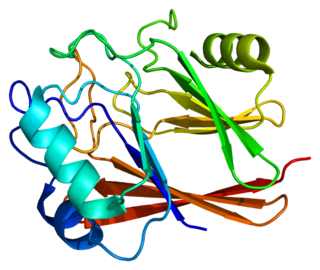
Sorting nexin-1 is a protein that in humans is encoded by the SNX1 gene. The protein encoded by this gene is a sorting nexin. SNX1 is a component of the retromer complex.

Sorting nexin-9 is a protein that in humans is encoded by the SNX9 gene.

Sorting nexin-2 is a protein that in humans is encoded by the SNX2 gene.

Vacuolar protein sorting-associated protein 26A is a protein that in humans is encoded by the VPS26A gene.

Sorting nexin-17 is a protein that in humans is encoded by the SNX17 gene.

VPS29 is a human gene coding for the vacuolar protein sorting protein Vps29, a component of the retromer complex.

TC10/CDC42 GTPase-activating protein is an enzyme that in humans is encoded by the SNX26 gene.

Spermine synthase is an enzyme that in humans is encoded by the SMS gene. The protein encoded by this gene belongs to the spermidine/spermine synthases family. This gene encodes a ubiquitous enzyme of polyamine metabolism.

Sorting nexin-3 is a protein that in humans is encoded by the SNX3 gene.

Cytochrome b561 is a protein that in humans is encoded by the CYB561 gene.

Sorting nexin family member 27, also known as SNX27, is a human gene.

Sorting nexin-13 is a protein that in humans is encoded by the SNX13 gene.

Sorting nexin-15 is a protein that in humans is encoded by the SNX15 gene.

N-terminal EF-hand calcium-binding protein 2 is a protein that in humans is encoded by the NECAB2 gene.

SET and MYND domain-containing protein 4 is a protein that in humans is encoded by the SMYD4 gene.

Ninein-like protein is a protein that in humans is encoded by the NINL gene. It is part of the centrosome.

Sorting nexin-4 is a protein that in humans is encoded by the SNX4 gene.

Sorting nexin-21 is a protein that in humans is encoded by the SNX21 gene.

Sorting nexin-18 is a protein that in humans is encoded by the SNX18 gene.

Phosphoribosyl pyrophosphate synthetase-associated protein 2 is a protein that in humans is encoded by the PRPSAP2 gene.




















